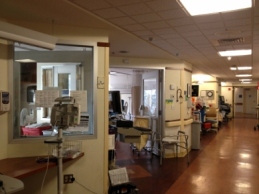Future Docs 3: The changing face of residency
After medical school, most doctors go through a kind of on-the-job training called residency. Residency programs have been around for a while, but some recent changes in those programs are impacting not only how residents practice but how patients receive care. So in the next Future Docs story, we take a look at residency from two angles. First, we meet third year general surgery resident Anne Kuritzky, who takes us on morning rounds on the surgical intensive care unit. Then, I join our Morning Edition host Elisabeth Harrison in the studio to talk about the showdown ahead on Capitol Hill over residency program funding and the changing needs driving residency specialization.
Transcript:
Residents still spend several years learning their specialties on the job from more experienced doctors. And they still get nervous their first night on duty.
“Oh my gosh, I was terrified!”
Meet Anne Kuritzky, a third-year resident in general surgery at Rhode Island Hospital. She’s remembering her first shift, her first year as a resident.
“I was there by myself overnight, which, now, wouldn’t be, in the new rules you can’t do that,” Kuritzky explains.
The new rules Kuritzky’s talking about say you can’t be there by yourself anymore. They’re established by the organization that accredits residency programs.
“That first night, when it got to be like 6 pm, and everyone else was like, ‘Alright, we’re going home.” And I mean, like, there are people at home you call if you have problems and stuff. But, it’s a little bit like, ‘OK. Now we’re getting into this. Now we’re going to do this.’”
And she got through it. With this simple goal in mind.
“You just want to make sure that you make it to the next day and so do all the patients. And you feel like, if that happens, you’ve won,” says Kuritzky.
Of course, there’s much more to it than that. As a general surgery resident, Kuritzky has been busy learning how to do everything from remove a gallbladder to how to care for patients after an operation—with more supervision. This morning, she’s about to begin morning rounds on the surgical intensive care unit.
“I’m here kind of starting my 24-hour shift…”
…Yep. A 24 hour shift. It sounds long – and it is. But, in fact, the number of hours residents can work has shrunk. Rules about duty hours were revised just last year because of concerns about residents not getting enough sleep. Now, they can only work 80 hours a week, on average. And some experts worry even that’s not enough to learn what you need to know. Which you learn, in part, by doing this:
“And so what we do is with my attending, and then we have a nurse practitioner and then also a critical care fellow,” Kuritzky explains, “we’ll go around as a group and we’ll talk about every patient in kind of a systems-based fashion and figure out what their plan is for the day.”
Translation: they’ll gather outside each patient’s room to talk about not only the surgery he’s recovering from, but how every system in his body is working. There’s something new about these morning rounds, too. That group Kuritzky mentions is a multi-disciplinary team, including a pharmacist and a nurse. The idea is to share information and make better decisions about a patient’s care. Just a couple of decades ago, a resident and her attending physician might not even know the names of the nurses on their ward, let alone ask them to join in. On this shift, Kuritzky kicks things off by presenting the patient to the others.
“OK,” Kuritzky says, “so first up, we have a 78 year old male.”
Attending physician Shea Gregg, Kuritzky, and the rest of the group circle up around a computer on wheels, just out of earshot of the patient. Because this conversation is for the doctors. The patient is an older gentleman recovering from some abdominal surgery. He’s resting in an arm chair just inside his room.
“Ok, pulmonary?” Gregg asks.
Gregg challenges Kuritzky to consider other possibilities, checks her understanding.
After they wrap up the presentation, it’s time to talk to the patient. Dr. Gregg leads.
“You feel better today? You look better,” Gregg says.
He was feeling a bit better, actually. And Kuritzky will be watching over him through the night. But in the meantime, there are seven more patients waiting to be seen. Orders to be written. Paperwork to complete. And it’s time to move on.





Kristin:
I heard this on the air this morning and was very impressed. I am not an expert on medicine but I have seen my share of the inside of hospitals – residents, nurses and the rest – and it is nice for me to be able to start to make some sense of what’s going on. Best regards,
M. Charles Bakst, J-School ’67